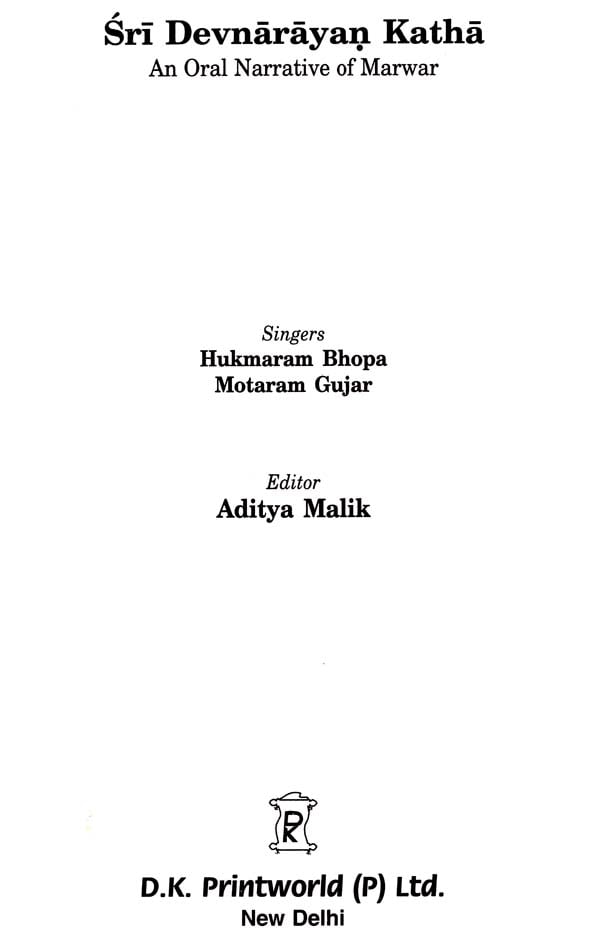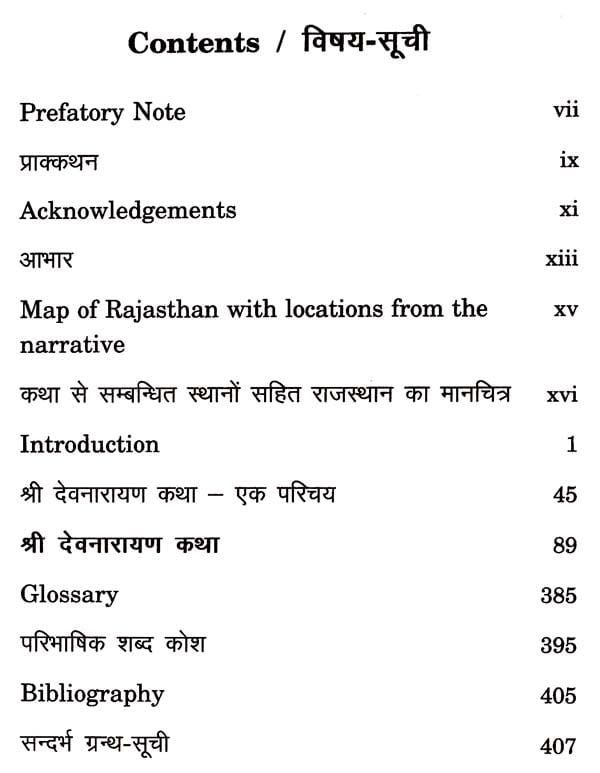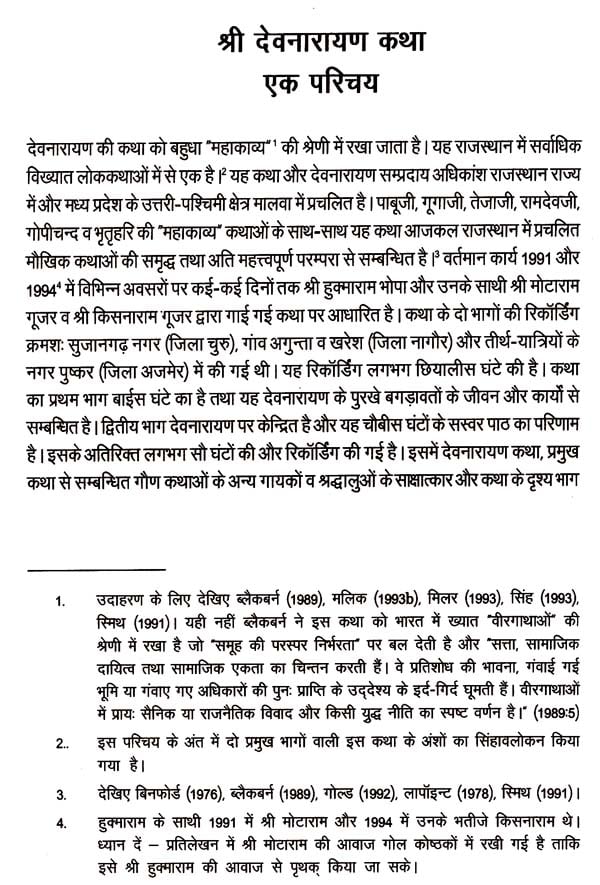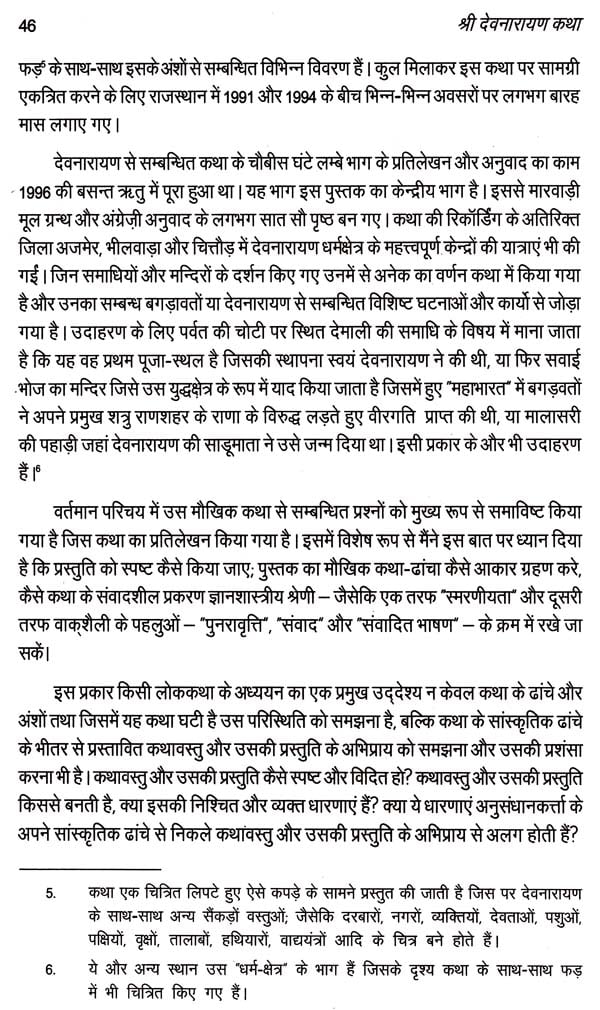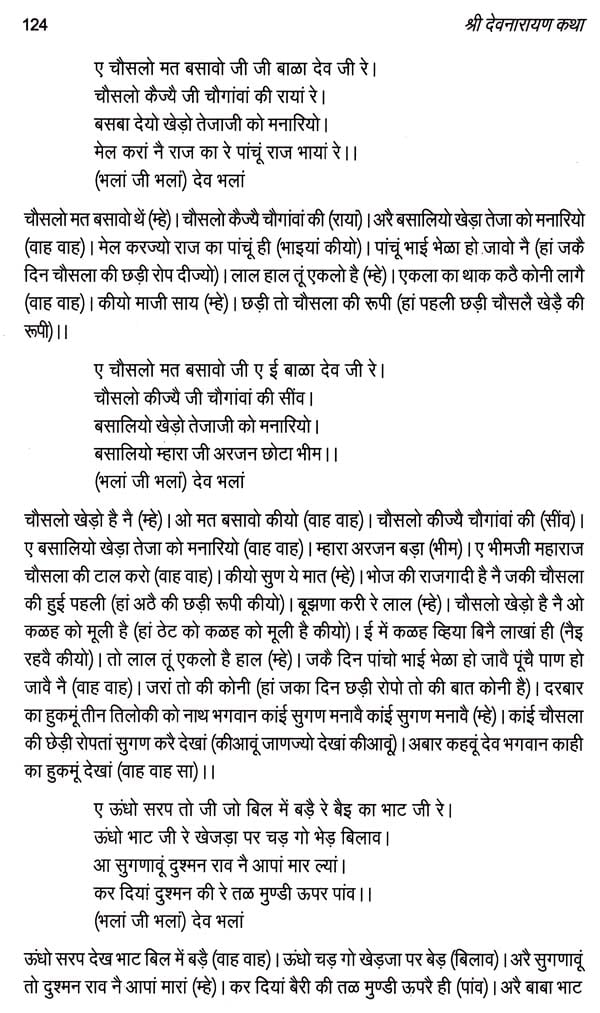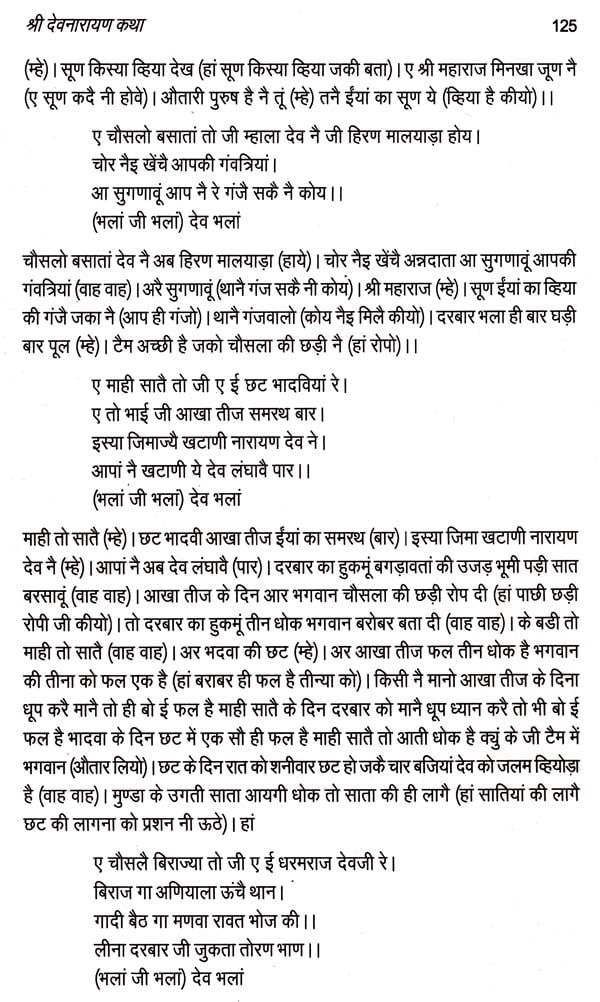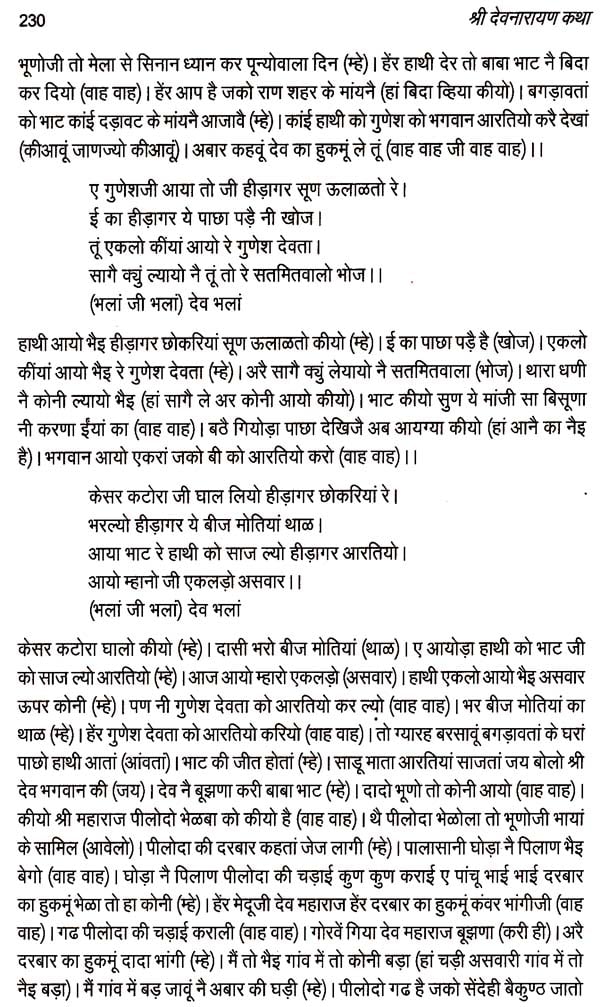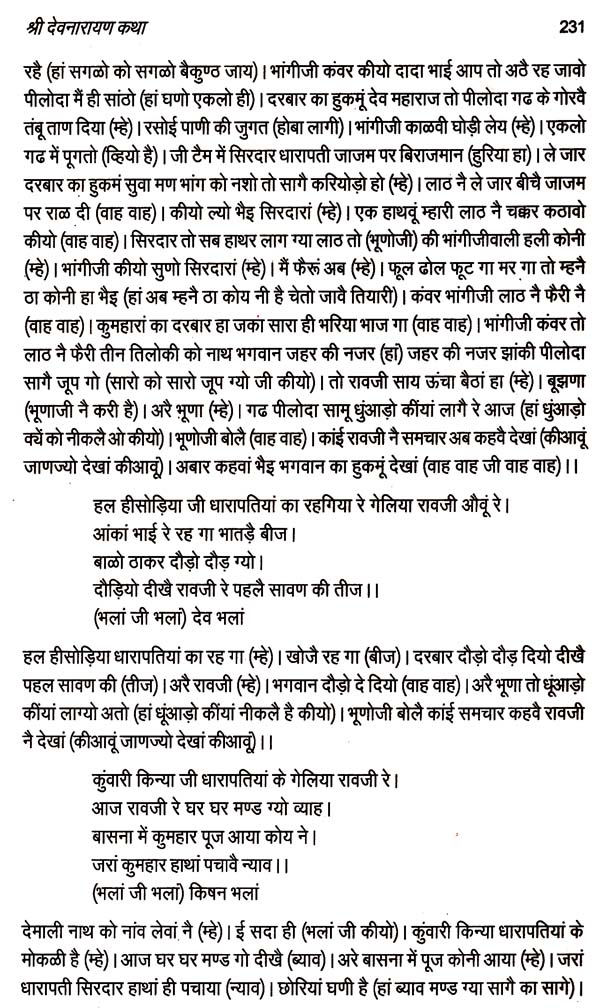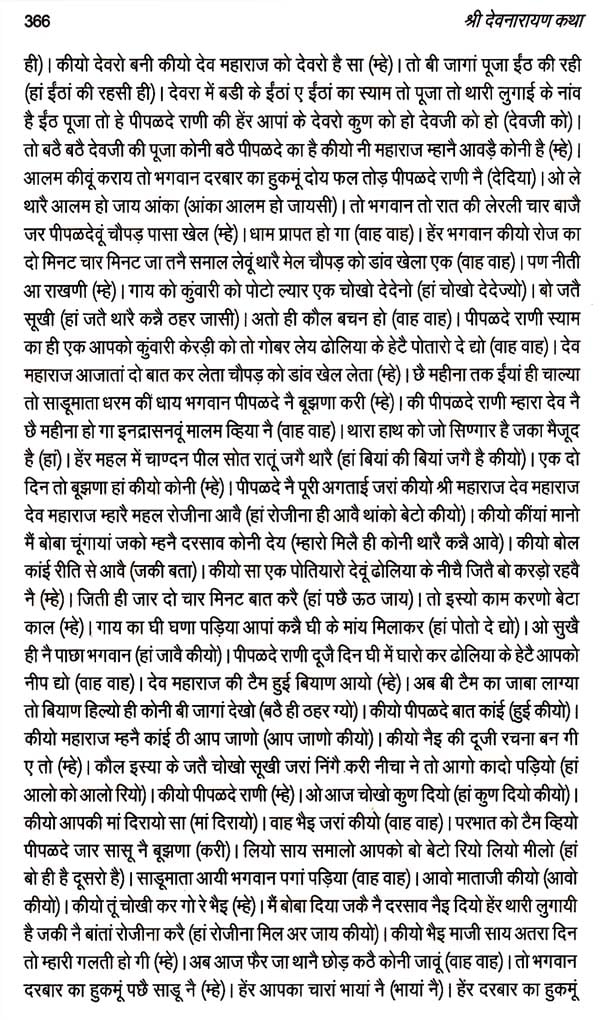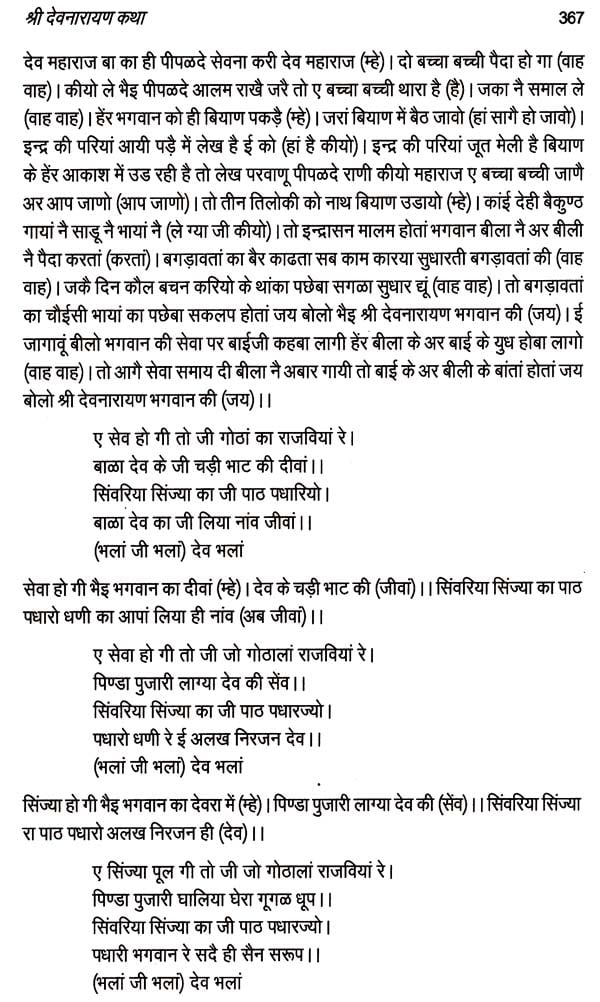
श्री देवनारायण कथा मारवाड़ का पारम्परिक गायन : Sri Devnarayan Katha (An Oral Narrative of Marwar)
Book Specification
| Item Code: | MZF323 |
| Author: | Aditya Malik |
| Publisher: | D. K. Printworld Pvt. Ltd. |
| Language: | Marwari |
| Edition: | 2003 |
| ISBN: | 8124602255 |
| Pages: | 408 (10 Color Illustration) |
| Cover: | HARDCOVER |
| Other Details | 9.00 X 6.00 inch |
| Weight | 830 gm |
Book Description
While providing insightful descriptions on how performances are conducted and who the performers are, the introductory chapter of this book (provided in English as well as in Hindi) raises a wide range of innovative issues pertinent to our contemporary understanding of verbal arts and oral traditions:
How is the oral recitation structured? What is the relationship between verbal and visual narrative? To what extent is meaning conversationally or dialogically produced within and through the narrative? These and other questions provide a fresh, new perspective on our understanding of the nature of oral traditions and their place within Indian culture.
THE narrative of Devnarayan - which has frequently been classified as an 'epic" - is one of the most well-known folk narratives in Rajasthan.' The narrative and Devnarayan's cult covers a large area extending over most of Rajasthan and Malwa, the north-western region of Madhya Pradesh. Together with the 'epic' narratives of Pabuji, Gugaji, Tejaji, Ramdevji, Gopi Cand and Bharthari, it belongs to a rich and significant corpus of oral narratives current in Rajasthan today.' The current work is based on a telling of the narrative recorded from Sri Hukmaram Bhopa and his companion Sri Motaram Gujar.4 The recordings of the two parts of the narrative were done alternatively in the town of Sujangarh (Churu District), in the villages of Agunta and Kharesh (Nagaur Dist.), and in the pilgrimage town of Pushkar (Ajmer Dist.). The total number of hours of recording time came to about forty-six hours: the first part of the narrative dealing with the lives and deeds of Devnarayan's ancestors, the Bagadavats, spanned some twenty-two hours; the second part which focuses on Devnarayan resulted in twenty-four hours of recitation. In addition to this, recordings amounting to roughly another one hundred hours were made. These consisted of interviews with other singers and devotees of Devnarayan, shorter narratives related to the main narrative, and various details regarding the content of the narrative as well as its visual counterpart, the pad.' All together approximately twelve months were spent in Rajasthan collecting materials on the narrative on three different occasions between 1991 and 1994.
The task of transcribing and translating the twenty-four hour long part of the narrative dealing with Devnarayan, that forms the centre-piece of this monograph, was completed in spring 1996, resulting in around seven hundred pages of Marwadi text and English translation. Apart from recordings of the narrative, field trips were also conducted to the important centres of the cult of Devnarayan in the districts of Ajmer, Bhilwara, and Chittor. Many of the shrines and temples that were visited are mentioned in the narrative, and are connected to specific events and actions related either to the Bagadavats or to Devnarayan. Thus for instance, the hill-top shrine of Demali is considered to be the very first place of worship that was founded by Devnarayan himself, or the temple of Savai Bhoj that commemorates the battle-field upon which the Bagadavats lost their lives in the Mahabharata against their arch-enemy, the Rana of Ran City, or the hill of Malasari where Devnarayan was born to his mother Sadd Mata, and so on.
Synopsis of the Narrative The narrative is composed of two main parts. These are recognised by singers as being distinct halves, and are called Bagadavat or Bagadavat Bharat and Sri Devnarayan Katha. The first half deals, as its title suggests, with the Bagadavats or the Twenty-Four Brothers who are the ancestors of Devnarayan. The second half, as is also clear from its title, deals with Sri Devnarayan. While both halves of the narrative extoll the heroic deeds of the Bagadavats and Devnarayan, they also articulate different sets of values. Above all, this is apparent in the sources of sacred power that each give prominence to. In the first half, sacred power flows from the devotional, self-sacrificial deeds of the twenty-four brothers. In the second half, it issues directly from the divine acts of Devnarayan, an avatar of Bhagavan.
BAGADAVAT BHARAT The first half of the narrative called the Bagadavat Bharat, has a time-frame spanning two world-ages. The beginning of the narrative is situated in the satya yuga at a time when Brahma is performing a Vedic sacrifice (Rajasthan: jug) in Pushkar, the famous pilgrim town in Rajasthan."
Brahma invites all the gods and rsis to his sacrifice in Pushkar. Among them is a group of twenty-four rsis living in the Nag Pahad (Serpent Mountain), a mountain chain running parallel to Pushkar. These rsis are disciples of Sankar. When Sankar hears of the invitation, he forbids them from attending the sacrifice. But they insist on going because they have been called by Brahma. All of a sudden Sankar grows ravenously hungry. The rsis suggest he eat the fruits growing in the forest in which they live. But Sankar claims this will not satisfy his hunger. He requires more than plain fruit. But what else is available in the forest? There is no cereal or grain either. So what does 8ankar do? He turns to his disciples and demands they offer their bodies to him. He commences consuming them one after another." After he has eaten them and satiated his hunger, he then takes it upon himself to visit Brahma's sacrifice. The sarifice comes to a halt because of the misdeed Sankar has commited." He asks Brahma how he should atone for his misconduct. Brahma lets him know that the only means would be to offer the rsis his own body in a future existence, in which the rsis are to be born as the 24 sons of a single father.
After this relatively brief spoken (not sung) prelude, the temporal frame of the narrative abruptly shifts to the kali yuga. The geographical location has not changed. It is the reign of the legendary medieval king, Raja Bisaldev of Ajmer.
The populace in the kingdom of Raja Bisaldev is being terrorised by a lion. In order to curb rampant killings, the king orders that one person offer himself as food for the lion every night. On one particular night, a Rajput called Hari Ram," who is travelling through the ill-fated kingdom, offers to take the place of a boy from the Kumhar community whose turn it is to be eaten by the lion. He tricks the lion by placing a figure made of dough at the place where it feeds. When the lion attacks the figure of dough, Hari Ram comes out of his hide-away and beheads it. Then in order to wash the blood off his sword, and to cleanse himself of the impurity of slaughter, he goes to the holy lake of Pushkar carrying the lion's head on his shoulder." It is full moon night (punam). Exactly at the same time on the opposite bank a Brahman girl called Lila Sevri who has taken a vow never to look at a man is performing ablutions and bathing in the lake. While bathing, she sees the reflection of a man's body with the head of a lion on the surface of the lake.
**Contents and Sample Pages**
